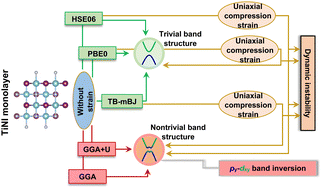New insights into band inversion and topological phase of TiNI monolayer†
Abstract
Two-dimensional (2D) topological insulators (TIs) hold great promise for future quantum information technologies. Among the 2D-TIs, the TiNI monolayer has recently been proposed as an ideal material for achieving the quantum spin Hall effect at room temperature. Theoretical predictions suggest a sizable bandgap due to the spin–orbit coupling (SOC) of the electrons at and near the Fermi level with a nontrivial ![[Doublestruck Z]](https://www.rsc.org/images/entities/char_e17d.gif) 2 topology of the electronic states, which is robust under external strain. However, our detailed first-principles calculations reveal that, in contrast to these predictions, the TiNI monolayer has a trivial bandgap in the equilibrium state with no band inversion, despite SOC opening the bandgap. Moreover, we show that electron correlation effects significantly impact the topological and structural stabilities of the system under external strains. We employed a range of density functional theory (DFT) approaches, including HSE06, PBE0, TB-mBJ, and GGA+U, to comprehensively investigate the nontrivial topological properties of this monolayer. Our results demonstrate that using general-purpose functionals such as PBE-GGA for studying TIs can lead to false predictions, potentially misleading experimentalists in their efforts to discover new TIs.
2 topology of the electronic states, which is robust under external strain. However, our detailed first-principles calculations reveal that, in contrast to these predictions, the TiNI monolayer has a trivial bandgap in the equilibrium state with no band inversion, despite SOC opening the bandgap. Moreover, we show that electron correlation effects significantly impact the topological and structural stabilities of the system under external strains. We employed a range of density functional theory (DFT) approaches, including HSE06, PBE0, TB-mBJ, and GGA+U, to comprehensively investigate the nontrivial topological properties of this monolayer. Our results demonstrate that using general-purpose functionals such as PBE-GGA for studying TIs can lead to false predictions, potentially misleading experimentalists in their efforts to discover new TIs.



 Please wait while we load your content...
Please wait while we load your content...